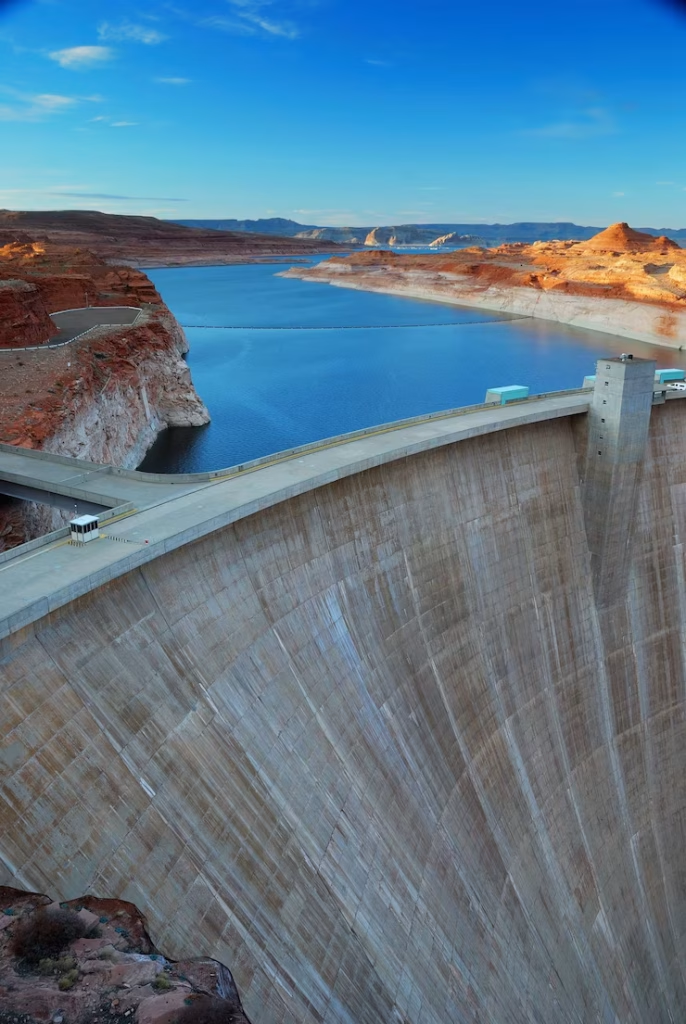
Harnessing rivers: The role of hydroelectric dams
Hydroelectric dams have long been a cornerstone of renewable energy, harnessing the power of rivers to generate electricity. These monumental structures, by controlling water flow, convert the potential energy of rivers into a reliable source of power for millions of people. While hydroelectric dams offer clean, renewable energy, they also raise environmental and social questions. This article explores the role of hydroelectric dams in modern energy systems, their benefits, and the challenges they present.
The basics of hydroelectric dams
Hydroelectric dams work by creating a reservoir of water, typically by blocking a river. As water is released from this reservoir, it flows through turbines, spinning them to generate electricity. The amount of power generated depends on both the volume of water and the height from which it falls. This system allows dams to produce a steady supply of electricity, making them a dependable energy source, especially for regions where river flow is consistent.
One key advantage of hydroelectric power is its flexibility. Operators can adjust the water flow to match electricity demand, making hydroelectric dams an excellent option for peak energy needs. Unlike solar or wind power, which depend on weather conditions, hydroelectric dams provide a reliable, controllable source of energy.
Benefits of hydroelectric dams
Hydroelectric dams play an essential role in clean energy production. By harnessing the natural power of rivers, they produce electricity without emitting greenhouse gases, which is critical for combating climate change. As countries work to reduce their carbon footprints, hydroelectric dams offer a scalable, renewable energy solution that can meet large-scale power demands.
These dams also support energy independence. Regions with abundant river systems can produce their electricity, reducing dependence on imported fossil fuels. This energy security is particularly valuable for countries aiming to strengthen their renewable energy portfolios and stabilize their energy supply.
In addition to electricity generation, hydroelectric dams provide other valuable functions. Many dams are designed to manage water resources, offering flood control and irrigation support. By regulating river flow, dams can help prevent flooding in downstream areas, protecting farmland, infrastructure, and communities. In arid regions, they also support agriculture by providing a steady water source for irrigation, which is essential for food production.
Environmental and social challenges
Despite their advantages, hydroelectric dams pose significant environmental challenges. The construction of a dam alters the natural flow of a river, affecting ecosystems both upstream and downstream. When a river is dammed, large areas of land are flooded to create a reservoir. This flooding can destroy habitats, displace wildlife, and even threaten local plant and fish species.
One of the most pressing ecological concerns is the impact on fish populations. Many rivers with dams are home to migratory fish species that rely on unimpeded waterways to reach spawning grounds. Dams can block these migrations, disrupting life cycles and leading to population declines. Some dams incorporate fish ladders or bypass systems to mitigate this issue, but these solutions are not always effective for all species.
Social impact is another major concern. Communities near river systems are often displaced during dam construction. Villages and farmland may be flooded, forcing residents to relocate. This displacement can lead to significant social and economic hardship for affected communities, particularly in regions where people depend on the land and river for their livelihoods.
Advances in dam technology and sustainability
To address these challenges, advancements in hydroelectric technology are making dams more sustainable. New turbine designs reduce harm to aquatic life, allowing fish to pass through turbines without injury. Additionally, researchers are exploring ways to minimize sediment buildup in reservoirs, which can extend the operational life of dams and preserve water quality.
Environmental impact assessments are becoming standard practice in dam planning, ensuring that potential effects on ecosystems and communities are thoroughly evaluated. Many newer projects include provisions for environmental restoration and social compensation, aiming to balance energy needs with ecological and social responsibility.
Small-scale hydroelectric systems, known as “micro-hydro”, offer another promising alternative. These systems harness river energy on a smaller scale without requiring large reservoirs or extensive environmental changes. Micro-hydro projects are particularly useful in remote or rural areas, where they can provide reliable, local electricity with minimal ecological disruption.
Hydroelectric dams around the world
Hydroelectric dams are a vital part of energy infrastructure in many countries. China leads the world in hydroelectric capacity, with massive dams like the Three Gorges Dam generating substantial portions of the country’s electricity. In Brazil, hydroelectric power supplies a significant share of the national grid, drawing from the Amazon and other rivers.
The United States and Canada also rely heavily on hydroelectric power, particularly in regions like the Pacific Northwest, where river systems support large-scale hydro projects. In Europe, Norway and Sweden generate most of their electricity from hydro, capitalizing on their mountainous terrain and abundant rivers.
These projects highlight the global importance of hydroelectric dams in providing stable, renewable energy. For many countries, hydro remains a cornerstone of clean energy policy and a critical tool in achieving sustainable energy goals.
The future of hydroelectric power
The future of hydroelectric dams will likely involve a shift toward more sustainable practices. As environmental awareness grows, there is increasing pressure to design dams that minimize ecological disruption. Floating solar panels installed on reservoirs, for instance, can augment hydroelectric power while reducing water evaporation and maximizing land use.
Retrofitting older dams to improve efficiency is another growing trend. Many older hydroelectric facilities were built with outdated technology and can be upgraded to increase power output while reducing environmental impact. By modernizing existing dams, countries can enhance their renewable energy production without constructing new dams, thereby avoiding further ecological disruption.
Hydroelectric power storage, known as pumped storage, is also gaining attention. In this system, water is pumped to a higher elevation during periods of low electricity demand and released to generate power during peak demand. Pumped storage enhances the flexibility of hydroelectric power, enabling it to balance grid loads and support intermittent renewables like wind and solar.
Conclusion
Hydroelectric dams play a critical role in renewable energy strategies worldwide. By harnessing the natural power of rivers, they provide a stable, scalable source of electricity that helps reduce reliance on fossil fuels. However, the ecological and social impacts of dams necessitate careful planning and responsible practices to balance energy needs with environmental stewardship.
As technology advances, the hydroelectric sector is evolving to meet modern sustainability standards. Through innovations in design, retrofitting, and small-scale systems, hydroelectric dams are becoming more adaptable to ecological concerns. With thoughtful management, hydroelectric dams will continue to be a valuable component of a sustainable energy future, contributing to global goals for cleaner, greener energy.
